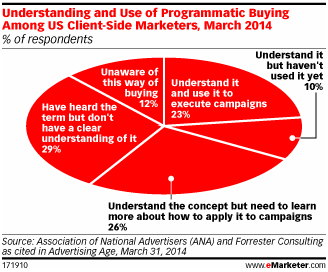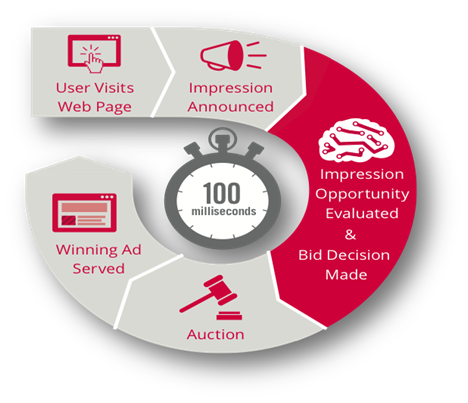Defining the Concept of Programmatic Buying
Programmatic buying is gaining increasing traction lately. Recent research shows that programmatic ad buying is going to increase in the coming years 
Many marketers are showing a lot of interest in programmatic buying. They are seeing it as a useful tool and want to know more about it.
What is Programmatic buying?
It is a system that allows buyers to purchase online display inventory from multiple sources such as, ad networks, ad exchanges and a few direct publishers.
Programmatic Buying is different from the traditional form of media buying that is done by individuals. This software driven approach to media buying comes with a host of benefits from speed to versatility to effectiveness that makes it attractive to marketers.
Programmatic Buying Process
Here’s a graphic that depicts the process of programmatic buying:

Source: Ogilvy grow (a Demand Side Platform or DSP)
The entire cycle of ‘bid-call-response’ illustrated above happens in real time and is completed within a timeframe of 100 milliseconds.
Advantages of Programmatic Buying
- Single Platform Execution – programmatic buying is a one stop solution to bid on online display inventory across multiple marketplaces
- Enhanced real-time targeting capabilities for optimization – programmatic buying allows you to implement numerous strategies such as:
- Behavioral targeting: you can utilize first party data captured on your website (IP address, cookie pool, user demographics) and third party data segments bought from Data Management Platforms (DMPs) like Bluekai and Lotame that will let you maximize campaign reach
- Audience or affinity group targeting: you can buy specific, appropriate audience groups and not irrelevant audience on websites. With audience analysis and segmentation, you can ensure increased reach with effective utilization of your spend
- Keyword contextual targeting: your ad will be featured on web pages that include specific, contextual keywords related to your campaign
- White-listing: you can create and use a white list of sites that have shown impressive performance in previous campaigns
- Re-targeting: you can re-target audience segments that have visited your site but did not take up any further action. This strategy is mostly used to engage your audience better and help them progress along the buying funnel
- SEM re-marketing: this tactic allows you to re-market to audience segments that are using campaign specific keywords on search engines
- Lookalike audience targeting: you can target audience groups with characteristics similar to customers who have completed the sales cycle
- Process transparency: The entire process is transparent, which includes real-time reporting, allowing you to have full access to all imperative metrics related to the promotional activity
- Programmatic buying provides the capability to post edits on the DSP, which is mirrored across the campaign’s reach in real time. Programmatic buying’s artificial intelligence based approach without human weaknesses (subjectivity, inconsistency etc.) makes it sound like the best of both worlds
Its early days and the jury is still out.
What do you think about the capabilities of programmatic buying? Do you think it will help marketers run better performing campaigns and derive more ROI?
Technical contribution by Kishore Kangokar, Group Head- Media, Position2 Inc.

